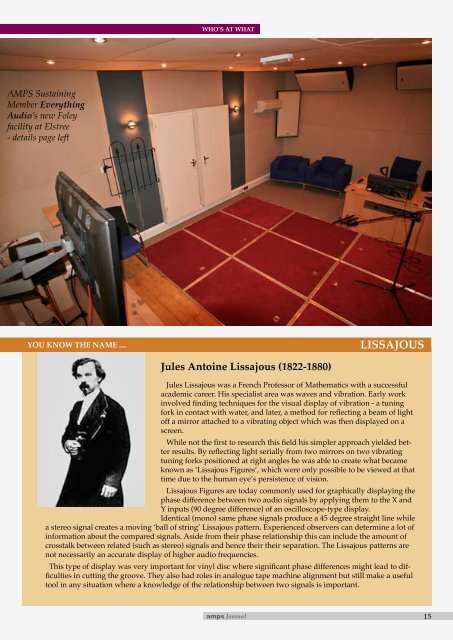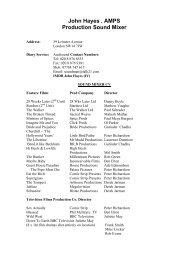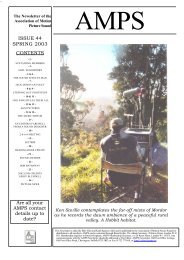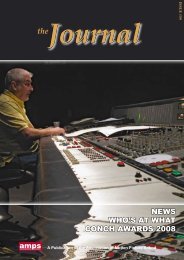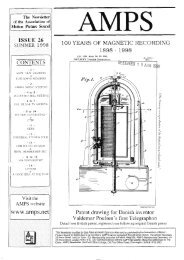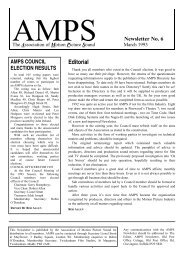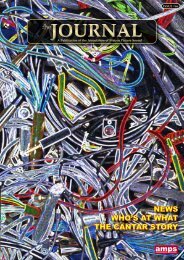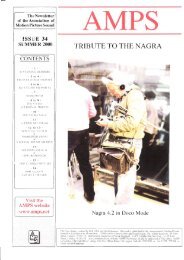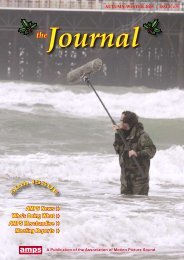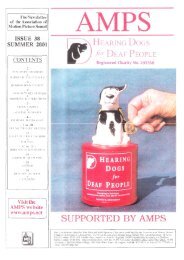from the sustaining members show - The Association of Motion ...
from the sustaining members show - The Association of Motion ...
from the sustaining members show - The Association of Motion ...
You also want an ePaper? Increase the reach of your titles
YUMPU automatically turns print PDFs into web optimized ePapers that Google loves.
AMPS Sustaining<br />
Member Everything<br />
Audio’s new Foley<br />
facility at Elstree<br />
- details page left<br />
YOU KNOW THE NAME ....<br />
WHO’S AT WHAT<br />
Jules Antoine Lissajous (1822-1880)<br />
LISSAJOUS<br />
Jules Lissajous was a French Pr<strong>of</strong>essor <strong>of</strong> Ma<strong>the</strong>matics with a successful<br />
academic career. His specialist area was waves and vibration. Early work<br />
involved finding techniques for <strong>the</strong> visual display <strong>of</strong> vibration - a tuning<br />
fork in contact with water, and later, a method for reflecting a beam <strong>of</strong> light<br />
<strong>of</strong>f a mirror attached to a vibrating object which was <strong>the</strong>n displayed on a<br />
screen.<br />
While not <strong>the</strong> first to research this field his simpler approach yielded better<br />
results. By reflecting light serially <strong>from</strong> two mirrors on two vibrating<br />
tuning forks positioned at right angles he was able to create what became<br />
known as ‘Lissajous Figures’, which were only possible to be viewed at that<br />
time due to <strong>the</strong> human eye’s persistence <strong>of</strong> vision.<br />
Lissajous Figures are today commonly used for graphically displaying <strong>the</strong><br />
phase difference between two audio signals by applying <strong>the</strong>m to <strong>the</strong> X and<br />
Y inputs (90 degree difference) <strong>of</strong> an oscilloscope-type display.<br />
Identical (mono) same phase signals produce a 45 degree straight line while<br />
a stereo signal creates a moving ‘ball <strong>of</strong> string’ Lissajous pattern. Experienced observers can determine a lot <strong>of</strong><br />
information about <strong>the</strong> compared signals. Aside <strong>from</strong> <strong>the</strong>ir phase relationship this can include <strong>the</strong> amount <strong>of</strong><br />
crosstalk between related (such as stereo) signals and hence <strong>the</strong>ir <strong>the</strong>ir separation. <strong>The</strong> Lissajous patterns are<br />
not necessarily an accurate display <strong>of</strong> higher audio frequencies.<br />
This type <strong>of</strong> display was very important for vinyl disc where significant phase differences might lead to difficulties<br />
in cutting <strong>the</strong> groove. <strong>The</strong>y also had roles in analogue tape machine alignment but still make a useful<br />
tool in any situation where a knowledge <strong>of</strong> <strong>the</strong> relationship between two signals is important.<br />
amps Journal 15


